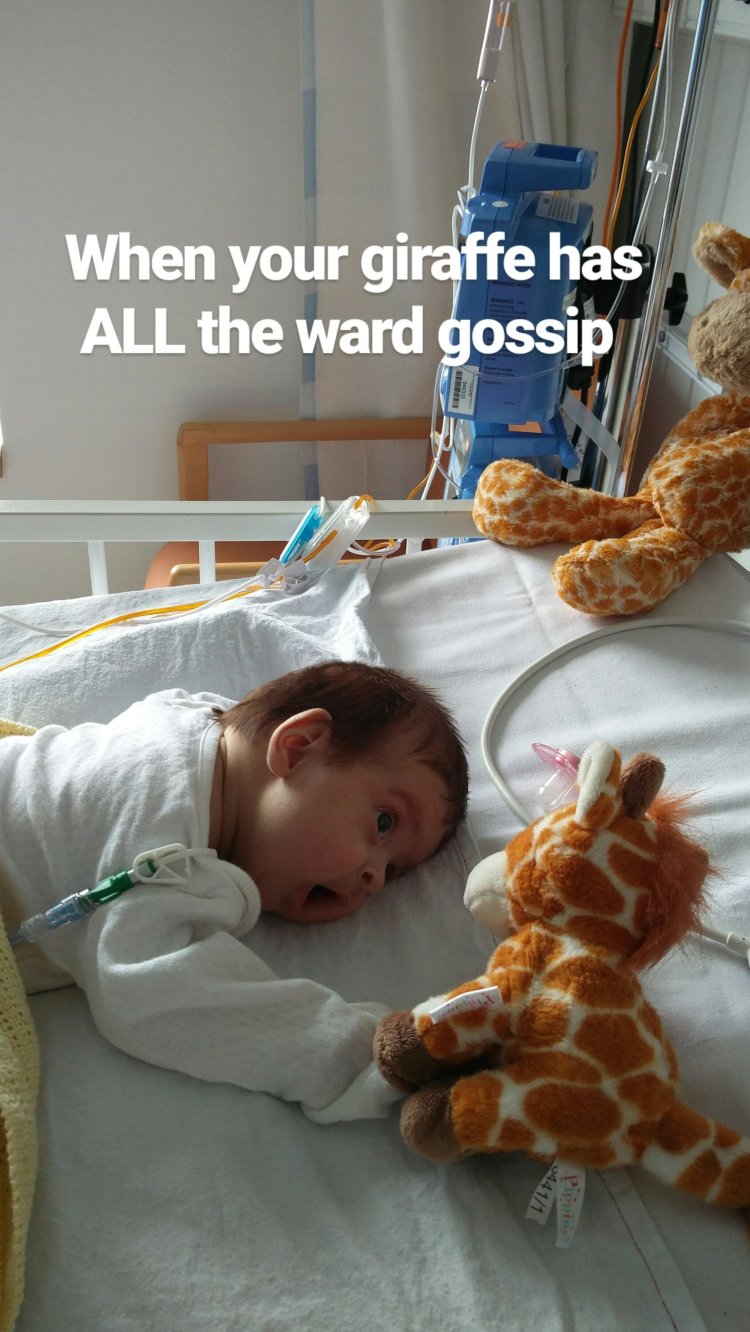I’d heard of a stoma, but I’d never seen one let alone cared for one. I’d certainly never even considered a baby might need one. Surprisingly, the majority of stomas in childhood are formed on babies – in fact, 1 in 10 need one.
Clara’s stoma is an ileostomy. The ileum is the last section of the small intestine and it’s been brought to the surface, forming a stoma. The purpose of this was to give her bowel chance to recover before the second attempt at reconnection in a few months.
Clara also has a mucous fistula. This is her colon exposed (another type of stoma) on the other side of her tummy. Essentially, it’s the part of the bowel the small intestine will be reconnected to. The purpose is to allow mucous and gasses (naturally produced by the colon) out. We’ll be using this to recycle waste from the ileostomy, putting it into the colon via the mucus fistula to get her colon working again.
Both the ileostomy and the mucous fistula are a wonderful red pink colour. Described as a rose bud by the nurses, or like a tongue sticking out by Dean… You pick your preferred description! Ideally, both are raised above the level of the skin so the outputs don’t irritate the skin surface. As Clara doesn’t have much bowel, not much could be used to create her temporary ileostomy so her’s sits quite flush. The challenge is this means the really acidic outputs are irritating her skin already.
It’s not easy caring for a stoma on a baby. The hardest thing is doing it single handedly, so if you’re able to get someone to help you then you’ve halved the battle.
In an ideal situation, you’d have a calm baby and all of your supplies ready. In an unplanned stoma bag change, that’s very unlikely.
Clara hates being naked and not having blankets on. So we rarely get off to a good start. We’ve also had repeated issues with Clara’s stoma bag leaking, sometimes a couple times a day, so we’re more often in the quick strip and change camp, over the leisurely daily bag change. I’ve yet to change her stoma bag when we are out and about, I’ve only had to do it in the hospital so far- but I have a supply kit in our nappy bag, I just need to find somewhere I can safely lay Clara down. I’m sure it won’t be long until I’m put to the test.
At first I was nervous of changing her stoma bag. I was terrified I’d not place the ostomy bag on properly, meaning her skin would get sore as it would leak. Yesterday, I changed her bag twice myself – I think I was lucky as Clara was relatively calm. Today however, she was not impressed when Shellea was trying to place a new bag on. Having an episode like that when we’re out still worries me but I know in the moment I’ll deal with it – simply because I have to. Note to self: just be prepared!
Things we keep in our stoma bag:
- An empty bottle to empty the ostomy bag contents into
- A syringe and quill to empty the bag with least mess possible
- Adhesive remover spray
- A bottle of sterile water (just because its small but ideally I’d skip this and use warm water)
- Gauze or dry wipes
- New ostomy bag already cut to size
- Scissors
- Tape
- Nappy bags
- A clean set of clothes
If you’re visiting a friend or family member who is caring for a baby with a stoma there’s a number of ways you can help:
Offer to be on ‘dummy duty’ if the baby takes a pacifier. Once mum or dad’s hands have touched the ostomy bag they won’t be able to touch baby’s dummy until they’re done and hands are thoroughly washed. But an absent dummy can result in baby being more upset, which in turn generates more liquid poo, which makes it hard to clean the site and put a new ostomy bag on.
Mum or Dad might ask you to hold baby’s legs straight by gently placing your hands on baby’s shins. They only get one chance to place the ostomy bag in the right spot, and a kicking baby doesn’t help.
If your baby has the stoma, don’t be afraid of doing ‘normal’ things. I needed reassurance from the nurses if was okay to put Clara in her car seat (obviously I know people with stomas travel in cars safely but I just wanted to be sure her car seat belt placements wouldn’t cause her bag to burst).
Clara still has tummy time, and she still cuddles into me with her tummy pressed against mine. I just make sure I empty the bag first! I’m nervous of taking her out in the baby carrier as I’ve not tested sustained pressure against me, but I’m sure we’ll try it soon when the weather perks up.


I didn’t also know that babies can also have that condition, and it surprised me that one out of ten babies is experiencing this. However, it’s great that there are available pieces of equipment for as patients that are as young as them. I hope there will be more comfortable options as time goes by. Thanks for sharing your experiences with us.
LikeLike
Sadly there’s not enough equipment specially for babies with a stoma as almost all of the research is into adult stoma care. But it is great that some equipment is available.
LikeLike
1/10 babies do not have this. I think she meant 1/10 stomas belong to babies? Interesting read!
LikeLike
Hi thanks for reading. Actually, I believe it is true. I’ve read 1 in 10 babies have stomas before the age of one year old.
LikeLike